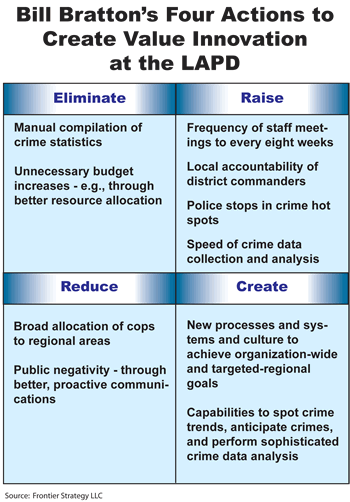Bill Bratton and the LAPD
Organization Snapshot
The Los Angeles Police Department (LAPD) is responsible for protecting 3.8 million people over a large, 465 square mile area.
Blue Ocean Strategic Move
After successfully reducing crime in New York City as its police chief in the 1990s, Bill Bratton joined the LAPD as chief in 2002. In his new role, Bratton repeated the Blue Ocean Strategies he used in New York by instituting new policies, processes and systems to control and reduce costs and simultaneously deliver a safer, better protected city to the public.
One of the key enablers of Bratton's approach was the adoption of the COMPSTAT computer statistics system. This tool allowed the department to collect and analyze crime data more accurately and faster than ever before. Now statistics could be tracked daily and weekly. This made it easier to spot trends and take action to prevent crime by allocating more cops to crime hot spots and notifying at-risk citizens and businesses through flyers and other communications.
Bratton's strategy also depended on the leadership and responsibility of his entire force to reduce and respond to crime effectively on a daily basis. He made captains in 19 local areas responsible for their district's crime reduction performance and required them to report results in front of their peers and himself every 8 weeks.
This increased local accountability and data-driven and continuous performance-improvement focus achieved results even when the department was facing major budget constraints and a lingering negative image from previous corruption and brutality scandals.
Success
Compared to 2002, gang-related murders in LA in 2009 were down 60% (and down 15% from 2008), robberies were down 16% and aggregated assaults were down by 45%. These results were much better than the national average, where, for example, the number of murders in America grew by 7% from 2000 to 2006. The crime reduction performance is also significant because LA had fewer cops in 2009 with a larger population to serve than it did in the 1990s.

